Dogs for grazing cows. Herding dog breeds
Herding dog breeds are among the oldest on the planet. Since time immemorial, man has domesticated wild sheep, goats and cattle. It was then that the four-legged friends became the constant companions of the shepherds. We bring to your attention a rating of the most popular herding dog breeds with names and photos.
The owner of a luxurious coat and high intelligence collie looks more beautiful in reality than in the photo. At first, she tended flocks of sheep and guarded peasant children, and then the royal people drew attention to her and she turned into a luxury pet. Today, the collie is ready to fill any of these roles and does not mind working in the police as a bloodhound. The peak of popularity of the Scottish Collie began after the release of the movie "Lassie". There are more than 10 Scottish Collie breeding nurseries in Russia. The price of a puppy ranges from 20 to 50 thousand rubles.
Historical Fact: Collie once saved a distillery from a fire and immortalized its name on a Scotch whiskey label.
Border Collie
One of the best "shepherdesses" and the smartest breed in the world. Border is the dream of any dog breeder, she is able to learn and memorize more than 25 commands on the fly. Works as a shepherd independently, without human intervention. Distinguishes each sheep by smell and knows how to get along with them. What distinguishes them from ordinary collies appearance... Borders cannot boast of special beauty and outwardly look like ordinary black and white dogs that can be found in any village. The uniqueness of their work can be seen in various show programs, as well as in the film "Babe". In nurseries of the Russian Federation, the price of a border collie puppy ranges from 25 to 50 thousand rubles.
Among the basic instincts of any dog, the most valuable is the ability to guard something. For a long time, people had meat and leather through livestock, carried out the transportation of various goods, which was significant for the people. For this reason, dogs were used to provide protection for various livestock, as there was always a risk of attack by predators.
The dogs were trained in a special way for grazing. And so it appeared herding dogs, descriptions of which are presented in this section of our website.
How Shepherd Dogs Appeared
It is generally accepted that shepherd dogs appeared long ago among the nomadic Asian tribes. Their large and brave animals could easily drive away a bear, a wolf, a stranger from the owner's herd. The improvement of the skills and abilities of such dogs began in Europe. The inhabitants of this continent believed that considerable size and boundless courage were far from complete list qualities that are necessary for shaggy shepherds.
These dogs should be different in color from predators in order to be noticeable at night and not act as a target for the master's gun. To obtain this color, the Europeans began to cross their dogs with local dogs, as a result of which the desired results were obtained.
Also, a significant contribution to the development of this group of breeds was made by the Roman people, who wanted to adapt animals to fight various predators. This section presents shepherd dog breeds with photos and names, which makes it possible to get general idea about these animals.
Since ancient times, man has domesticated sheep, goats, and then cattle. At the same time, the dog is a constant companion of man in the pasture. This magnificent companion not only helped in grazing the herd, but also protected it from the attacks of predators. Initially, all representatives of this group were called shepherd dogs, and only centuries later were shepherd breeds determined. Each breed of herding dog has its own positive qualities and characteristics.
Peculiarities
All representatives of this group have the following common features:
- medium size, proportional physique;
- significant endurance, the presence of developed muscles - for prolonged loads;
- thick coat, undercoat - protection from all weather conditions;
- poorly developed hunter instinct;
- excellent security guard qualities, distrust of strangers. When the need arises, the dog begins to chase the beast;
- boundless courage, courage;
- devotion to their master.
Currently, the shepherd dog shepherd dog is especially popular, as it has amazing guarding qualities, great appearance and a lot of other excellent characteristics.
These dogs can perform various jobs... They do not get tired, for this reason they need stress and activity. Also, representatives of this group get along well with young children, so they can be kept in a private house where there is a baby.
Naturally, leaving the child alone with the dog is undesirable, since these dogs are of medium and even large sizes. During the game, the pet can accidentally push the child. Moreover, all shepherd and cattle dogs presented in this section have a large number of positive qualities and merits.
Since the days when sheep, goats, and then cattle were domesticated by man, the dog has become his constant companion on pastures. This four-legged friend not only helped herd the herd, but also protected them from the attacks of predatory animals. At first, all shepherd dogs were called shepherd dogs, and only after many centuries were the shepherd's dog breeds determined.
And all this time, from the first primitive breeds, those that have the necessary set of qualities were carefully deduced:
- Average body size with proportionate physique.
- Endurance and well-developed musculature - for large and prolonged loads.
- Thick coat with undercoat - for protection from bad weather or heat.
- Poorly developed hunting instinct (so that the dog is not distracted from its direct duties).
- Excellent security qualities, distrust of strangers. If necessary, the dog can chase the animal.
- Selfless devotion to the owner.
- Courage and courage.
Geography of breeding herding dogs
The geography of the countries where the shepherd's dog breeds were bred is quite extensive. Moreover, the more developed animal husbandry is in the state, the more more breeds of dogs in this category it is the homeland.
For example, Hungary is home to five common herding dog breeds - Commander, Bullet, Pumi, Mudi, and Hungarian Kuvasz. The first two are long-haired, capable of perfectly enduring even the most fierce weather. Pumi is a relatively young breed, bred by crossing a bullet and a Pomeranian. She is used not only as a herd guard, but also as a watchdog, as well as a rodent exterminator. And the Hungarian Shepherd Dog (Mudi) is an even younger breed, obtained by crossing several breeds, including bullets and pumis.
Slovakia, in which there is no mountainous terrain, and, accordingly, livestock breeding is less developed, in its history it has bred only one breed of herding dogs - the Slovak Chuvach, which is closely related to the Hungarian kuvasz.
English shepherd dogs are very popular. This is the well-known collie (Scottish Shepherd Dog), as well as the Sheltie, Bobtail. You can often see little handsome Welsh Corgs. It was this dog breed that was preferred by the royal family of George VI. And a dog of this breed was presented by the king as a gift to his daughter Elizabeth II. And all because their representatives are very smart, they know how to perfectly overcome difficulties and perform their functions.
Swiss herding dog breeds are one of the few remaining, thanks to the skillful actions of breeders, in its pure form up to today... Four types of Swiss shepherd dogs with a unique color in the form of a tricolor - this is a significant contribution of Switzerland to the science of canine. The Great Mountain Dog (or Great Mountain Swiss Shepherd Dog) has as much as 72 cm at the withers and has a smooth coat. The Bernese Shepherd Dog (Bernese Mountain Dog) is already long-haired, with a withers 65 cm. Well, the Appenzeller Mountain Dog and Entlebucher Mountain Dog are short-haired, 58 and 35 cm, respectively. The photo shows the Bernese Mountain Dog.
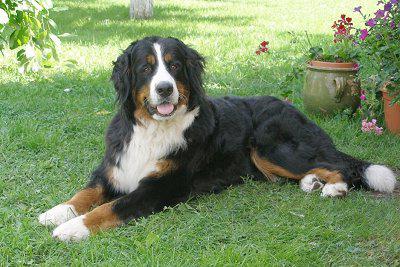
Belgium also contributed to the breeding of herding dogs. And very weighty. In Belgium, breeds of dogs were bred, the herding qualities of which correspond to high level and are appreciated all over the world. Versatility, excellent guarding abilities, similar physique, height 62 cm at the withers - these are the Belgian shepherd dogs. They differ only in color and type of coat. So, dogs of the Groenendael breed have long black hair, and the representatives of the Tervuren breed differ from the first ones in bronze color with a black tint. Another herding dog, the Malinois, has the same color, but it has a shorter and tighter coat. But the Laekenois is a breed of wire-haired Belgian herding dogs.
Australian cattle dog
It is a cattle-driving breed, and its second name, healer, it got due to the manner of grabbing cattle by the teeth by the lower part of the hind limbs (from the English heel - heel) when driving the herd.
The Australian Cattle Dog has a body length of 44-51 cm, its color can vary from red to dark gray. This is an extremely unpretentious and hardy animal, always active and ready for decisive action. Ideal conditions for a dog - staying on fresh air most part of time. It gets along well with other animals. With vigilance and a firm grip, the dog also performs well in restraint work.
The history of the breed originates in the middle of the 19th century, when the development of the Australian state of New South Wales took place. Along with the cattle, cattle breeders brought here herding dogs - Smithfields (black bobtails), which were not adapted to the heat, were too large and noisy, which frightened the animals.
The first attempt by farmers to cross a Smithfield with a dingo (in 1830) was unsuccessful: the red short-tailed dogs worked quietly, but bit hard. An attempt to cross a Rough Collie with a Bull Terrier was also unsuccessful. And in 1840 the landowner Thomas Hall ordered two collies (black-blue and gray-black-marbled) from Scotland, which were then crossed with a dingo. This is how the Australian shepherd dog was obtained with a blue color. It should be noted that the same was done by the farmer J. Elliot from Queensland, and some people still call this breed the Queensland. A little later, Sydney farmers mixed the healers with Dalmatian blood, thanks to which the breed inherited the mottled roan pattern of the "shirt".
The breed received its recognition in 1903 thanks to Robert Kaleski, who initiated its first standard. In 1963, it was released in a modern interpretation, and in 1987, its last version, FCI, was released. In 1979, the standard was approved by the AKC. Also, recognition of the breed is confirmed by SKS, UKC, KCGB and ANKC.
Australian kelpie
The breed got its name from the water kelpie mentioned in the work of Louis Stevenson.
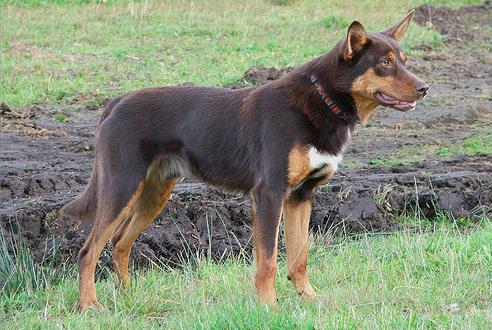
The Australian Kelpie is a very active dog, with an excellent combination of muscular strength and great flexibility in the limbs. Possesses high intelligence, is distinguished by loyalty to a person and dedication to work. Despite its average size (43-58 cm at the withers), the dog does an excellent job of grazing even cattle. Has a short coat of black, black and tan, red, red and tan, fawn, chocolate or smoky blue.
The history of the breed is not fully understood. The first mention of it dates back to 1870. Wide use received a version that the emergence of the breed was the result of crossing the border collie with a wild dingo dog. The Australian Kelpie does have a wild dog's habits. For example, when grazing, it bends its head to the ground, as if sneaking up on the victim. In general, dogs of this breed can single-handedly graze a thousand sheep. In their work, they use such techniques as biting defiant animals by the legs, as well as jumping on their backs to quickly reach the other end of the herd.
The breed has been recognized by the FCI standard.
Azores dog
Dogs of this breed are extremely rare. Only directly in the Azores, and occasionally at competitions and exhibitions, you can meet its representatives. Although in its homeland the Azorean Shepherd Dog is invariably deservedly popular - its excellent working qualities, as well as boundless loyalty to the owners, make these animals real favorites of the family.
Azores dogs belong to the category of cattle-driving dogs, they are distinguished by a rather lively temperament, they perfectly cope with the function of grazing cows and other large livestock, they perfectly conduct a guard service. The breed is characterized by a height at the withers, corresponding to 48-60 cm, and has a short brindle coat.
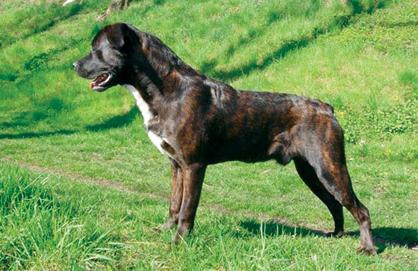
This dog breed has another name - Cao de Fila de Sao Miguel - identical to the name of the largest of the Azores. The fact is that during the period of active expansion of their possessions by Portugal, in 1427, Heinrich the Navigator discovered the Azores. The presence of lush vegetation and the absence of mammals on them have become a hindrance to the settlement of the islands by people. Then Henry gave an order to bring cattle to the island of San Miguel, and already in 1439 there were abundant herds of animals, gradually running wild without human presence. It was then that the need for a shepherd's dog arose. The dogs introduced by the settlers became extinct, but their crossing with other molossians gave birth to a different breed, which got its name after the island.
Due to the almost complete isolation over the centuries, the Azores shepherd dogs have kept the breed pure. And only the development of external relations gave rise to the danger of losing her purebred. Therefore, in 1995, a breed standard recognized by the FCI was described.
Caucasian Shepherd Dog
The Caucasian Shepherd Dog breed is one of the oldest (it is more than 2000 years old).
Is also one of the largest breeds(up to 75 cm at the withers, 45-70 kg). According to the type of coat, dogs of this breed are short-haired, with an intermediate length, and also long-haired. But they all have a thick undercoat. The color can be wolf gray, brown, fawn, red and variegated.
There are two versions of the history of the breed. According to one of them, the breed originated from the Tibetan Great Danes and dates back to 1211 BC. NS. when Chinese emperor Zhou was presented with one of these dogs. However, there are images of similar animals on the remains of the Caucasian state of Urartu (7th century BC).
But whichever version they adhere to, one thing is clear - the ancient breeders-dog handlers did a great job. The dog is smart, hardy, copes with shepherd and guard duty, has determination and courage.
The bright appearance and impeccable performance characteristics of this dog captivate even those who are neutral towards our four-legged friends. Of course, it comes about the scottish shepherd, collie. It is not in vain that the price of a puppy with a pedigree starts at 15,000 rubles - after all, its representatives are the standard of canine beauty, devotion and intelligence.

There are several versions of the origin of the name of the breed. According to one of them, it is associated with a variety of Scottish colley sheep. On the other - with the word coaly, which means "coal". Well, the third suggests the connection of the name with the English word collar, which translates as "collar" and indicates the chic mane and frill inherent in this breed. The royal appearance, the proud posture of its representatives, the muscular physique, graceful movements, as well as the magnificent thick and long coat, were appreciated by Queen Victoria, who traveled through the Scottish lands. And since 1860 collies began to take part in exhibitions. Ever since breeding work with the breed was solely aimed at the conformation and did not concern the performance of the dog.
Today the collie is the personification of intelligence and beauty in the canine world. The sharp mind of the dog allows it to master not only a standard set of commands, but also to learn the meanings of many words. Dogs are obedient, quick-witted, become excellent friends and helpers for children. In short, if you decide to have a collie puppy, the price you pay for a purebred breed, although it will be rather big, will fully meet your expectations from the acquisition.
Sheepdog from Portugal
The Portuguese Shepherd Dog has long been prized for its herding qualities. The manner of her behavior is to drive the cattle by barking, and also by silently walking around the flock or herd when grazing.
It is a medium-sized dog (42-55 cm, 12-18 kg) with thick, long and slightly harsh coat. There is no undercoat. Modern representatives of the breed are predominantly black, but there are individuals of gray, reddish, yellow and brown colors.
As you might guess from the name, the native breed is Portugal, or rather its regions Alentejo and Ribatero. Experts admit a close relationship with such breeds as the Briard, Pyrenean and Catalan Sheepdog.
Excellent watchdog qualities, tolerance to various weather conditions and unpretentiousness in food, as well as vigor, vigilance, and at the same time calmness and poise - all these qualities are inherent in the Portuguese shepherd dogs.
Romanian Shepherd Dog
The breed of the Romanian Shepherd was probably the result of the crossing of shepherd dogs of various breeds, possibly Slavic and Turkish.
A dog of this breed is characterized by a white color (or with brown speck), which is very convenient - such a dog is not afraid of sheep, it cannot be confused with wolves. The coat is straight, dense, of medium length. The dog has a height at the withers of about 58-66 cm, weight in the range of 32-45 kg, strong bones, short and strong neck, well-developed muscles.
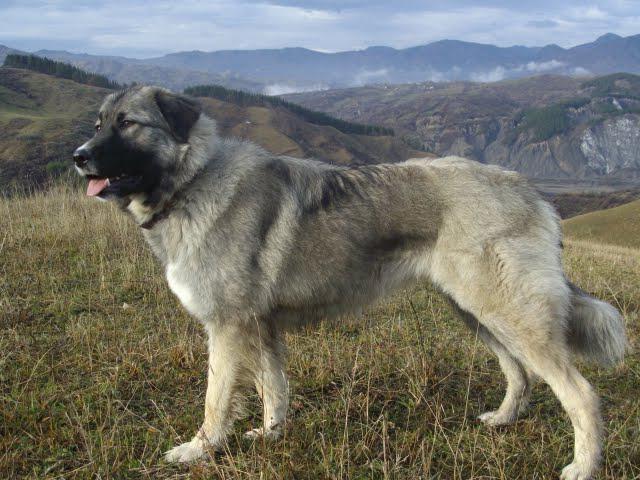
Romanian Shepherds are very reliable herders, perfectly adapted to the harsh local conditions. These are very hardy dogs with lightning-fast reactions and innate aggressiveness. The breed is quite rare and little known outside the borderline of its homeland.
Czech dog
The Czech Shepherd Dog is one of the oldest breeds and possibly the predecessor of the famous German Shepherd Dog.
These shepherd dogs are 50-55 cm tall and weigh 15-25 kilograms. They have a proportional head and an elongated muzzle. The ears are pointed, of medium size, close to each other and set high. The muscular body also has a strong bone structure. A saber-shaped tail completes the ideal exterior. The coat is straight, elongated (up to 12 cm), with a thick, well-developed undercoat, thanks to which the dog tolerates severe frosts and summer heat... The coat is black in color and tan reddish on the cheekbones, around the eyes, on the chest, on the front of the neck and on the limbs.
Having a lower height and weight than other working dogs, the Czech Shepherd Dog is more comfortable to keep, more maneuverable, very active and quickly gets involved in work.
It should be noted that, along with the official one, the breed has other names, one of which is the Hodskaya dog (from the Czech ethnic group Hodi, which has long guarded the way to Germany in the mountains of the Czech Republic). The history of the breed begins in the 13th century, and in the 16th century its breeding was already at a professional level.
Then, in 1984, the restoration of the breed began thanks to the work of Vilém Kurz and Jan Findeys. In one cynological publication, a photo of a walking shepherd dog was published and an appeal to readers to report the presence of such dogs. So, in the period from 1985 to 1992. 35 litters of this breed were registered. In 1997, Findeys introduced the official standard for the Czech shepherd dog.
South Russian
Distinctive feature and the pride of the breed is its coat. First, it is soft, silky and very long. On the head, the wool covers the muzzle and reaches the tip of the nose; on the legs, it forms a kind of boots. Coat color can range from pure white to yellowish and smoky. But this harmless, as it seems at first glance, appearance hides under itself a rather aggressive nature, designed to carry a shepherd and guard duty.
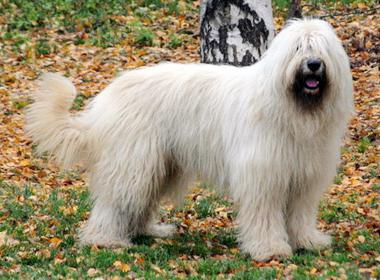
How did the South Russian Shepherd Dog appear? The history of the breed dates back to 1797 when Asturian shepherd dogs were brought to Tavria, together with the first pairs of fine-fleeced Spanish sheep, to help cattle breeders. As excellent shepherds, these dogs had a significant disadvantage. Their small stature and light build made them very vulnerable to the local steppe wolves. Therefore, the sheep breeders needed to turn the brought dogs into stronger ones, without losing the existing shepherd skills. By infusing the Asturian four-legged shepherds with the blood of Tatar shepherds, local greyhounds, and Russian hounds, they bred a breed of dogs with such qualities as endurance, speed in running and viciousness towards predators. At the same time, the dog is unpretentious in content, intelligent, affectionate with his own and has a lightning-fast reaction. Tribal work was carried out in the famous Askania-Nova estate, therefore the breed was named the South Russian Shepherd Dog. Sometimes this shepherd is also called Ukrainian.
But unfortunately, the breed has not become popular by now. The fact is that during the First and Second World Wars, due to the reduction in the number of sheep, the development of the breed stopped. As a result, by 1945, rare specimens of the breed remained only among its true connoisseurs, as well as local shepherds. Of course, since then the number of dogs has increased, but the breed has not gained popularity. There are several reasons for this. Firstly, the activity of the animal is such that a lot of space is required, which is impossible in apartment conditions. Modern sheep breeding no longer needs so many service dogs. And other skills, for which the shepherd's dog breeds have the ability, have not been mastered by the South Russian Shepherd Dog.
People have been keeping and raising livestock for a long time. And an excellent assistant in such tricky business can become a dog. But not all breeds will cope with the responsibility, although some have all the qualities of professional shepherds.
A dog is a true friend of man and a real helper
It is not for nothing that dogs are considered our smaller brothers, because these animals have not only been in close contact with people for a long time, but also have unique qualities similar to human ones. Some breeds have existed for a long time, others were bred specifically for some specific purpose, so it is not surprising that dogs can perform many tasks, including quite complex ones. For example, they are able to help shepherds or even replace them partially or completely.
What qualities will help a dog become a real shepherd? First of all, courage, because you may have to repel the attacks of wolves and other wild animals. Also, the dog must be careful to monitor the entire herd. And the speed of reaction and agility are also very much appreciated, allowing not only to immediately notice the stragglers or lost sheep or cows, but also to quickly return them. These qualities will also come in handy when moving a herd from pen to field and back.
The best herding dog breeds:
- Australian cattle dog(also called a cattle dog or healer). Firstly, such animals have strong muscles and a well-developed musculoskeletal system, which allows them to move actively and for a long time. Secondly, having received the task, the dog will closely observe his charges, not for a second taking his eyes off them. Thirdly, herding dogs are completely unpretentious: they eat literally everything and quickly adapt to new conditions. And, fourthly, they work harmoniously and accurately as a team, interacting with each other and distributing tasks. it perfect option for driving livestock over long distances.
- Australian shepherd breeds are considered one of the best herding breeds in the world. kelpie... And the main reason for this is a genetically determined quality: representatives of this breed have very wide angle overview that allows you to take a look at even a large herd and always keep the situation under control. In addition, Australian kelpies are incredibly hardworking and energetic, so fulfilling the duties of a shepherd will give them great pleasure and provide a burst of energy. And also these dogs are quite obedient and accommodating, but sometimes they may disagree with the owner and make decisions on their own.
- Border Collie... Their homeland is Great Britain, and these dogs have long been loved by many farmers, since they are literally created for work and can help a person almost around the clock, getting real pleasure from it. Also, the breed is valued for its endurance, the ability to take independent decisions and very high intelligence. The Border Collie can graze not only any animals, but also birds, and a few years ago these dogs were recognized by Columbia University scientists as the smartest. But the owner must prove his authority, as well as be reasonable and calm, so that the pet becomes a faithful assistant for him.
- They have long been helping to keep livestock and bergamasco, which were brought to Europe about two thousand years ago. They possess all the qualities that enable them to be excellent shepherds. Among them, it is worth noting an excellent hearing. And a unique sense of smell helps them in finding missing animals. Some farmers even claim that the representatives of this breed literally know every sheep by the smell and perfectly distinguish “outsiders” from “their own”. Also, Bargamasco are used as rescuers and guards, and they are also incredibly hardy and can withstand any temperature extremes and whims of nature.
- Bullets- a medium-sized breed of dogs of Hungarian origin. A distinctive feature is a very long and curly coat, which reaches the ground in some representatives. And it is this coat that makes the breed hardy, providing protection from cold, wind and rain. Bullets are highly efficient, so they have a good attitude to work and are happy to carry out the tasks of the owner. Dogs are incredibly loyal and can be trained and trained very well and can learn a wide variety of skills.
- Pyrenean shepherd can perform the most different tasks and therefore become successful rescuers, searchers, watchmen, shepherds and just companions and assistants in any business. By the way, during the First World War, these dogs were part of the guard service, and also helped in the search for the wounded in battle.
- Entlebucher Mountain Dog- the smallest variety of Mountain Dogs. Switzerland is considered the birthplace of the breed, and representatives almost always lived in the mountains and helped shepherds to drive herds. Such dogs have a rather gentle character, the main trait of which is helpfulness. Such a pet will literally do anything to please its owner and please him. In addition, entlebuchers are very quick-witted, therefore they become loyal and quick-witted helpers. And they are also dexterous, perky and selfless.
- German Shepherd - a breed that has been known for a very long time and has served people from the very first days of its existence. Initially, she was bred as a shepherd, but thanks to the unique intellectual abilities, the dogs began to actively master other skills, becoming excellent watchmen, search engines, rescuers. This is an excellent companion, and not only devoted, but also hardworking, always ready to help and do any job. The German Shepherd will respect and love the owner and will become a full member of the family.
- Bobtail (Old English Sheepdog)- This is the result of crossing the Briard (he is also considered a good shepherd) and the South Russian Shepherd Dog. These dogs have long been considered excellent shepherds, and were mainly used for these purposes. But today, bobtails are not as popular with shepherds, in large part because of the rather unusual and maintenance-intensive wool. Today, representatives carry out the tasks of guards and watchmen, but more often they become companions. In any case, they are very smart, quick-witted and hardworking.
- Welsh corgi Is one of the oldest British breeds. The exact origin is not known for certain; many different legends are associated with it. One way or another, representatives of this peculiar breed from the earliest times were considered excellent shepherds, which is once again confirmed by documents dated from the XII century, which indicated that the owner was entitled to compensation for the murder of a Welsh Corgi, which grazed cattle. Other dogs were not so highly prized. Distinctive feature breeds are short legs, but it is they that allow the animals to be nimble and easily dodge the hooves of livestock.


